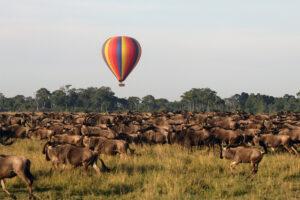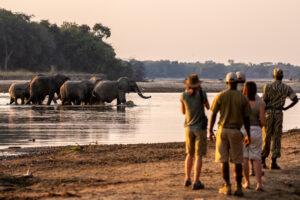Safari Consultants: Top 3 Iconic Safari Destinations in Africa to visit, presented by Safari Consultants
2024 Top 3 Iconic Safari Destinations in Africa to visit: Kenya’s Masai Mara, Botswana’s Okavango Delta and Zambia’s South Luangwa
Africa’s famous safari destinations, the Masai Mara, Okavango Delta and the South Luangwa, beckon travellers with their exceptional wildlife encounters and breathtaking landscapes. While all offer unforgettable safari experiences, each boasts its own unique allure and distinct ecosystem. These safari areas offer unparalleled opportunities to witness Africa’s incredible wildlife in their natural habitats, providing memorable experiences for travellers seeking adventure and exploration.

Masai Mara, Kenya:
Location: The Masai Mara region is found in southwestern Kenya, and encompasses the Masai Mara National Reserve together with exclusive conservancies along the north and eastern boundaries. It is part of the larger Mara-Serengeti ecosystem that spans Kenya and Tanzania.
Wildlife: The Masai Mara is renowned for its abundant wildlife, especially during the Great Migration (July to October) when millions of wildebeest, zebras, and gazelles move through the area in search of greener pastures. Besides the iconic migration, the area is home to the Big Five and hosts an impressive array of predators, including lion, cheetah, leopard, and hyena. The birdlife too is impressive with over 500 species recorded.
Activities: Game drives are the main activity in the Masai Mara National Reserve, offering visitors the chance to explore the vast savannahs and encounter wildlife up close. But in the private conservancies there are opportunities for more immersive guided walks and even fly-camping adventures. Hot air balloon safaris provide a unique perspective, floating over the plains at sunrise. Cultural visits to Maasai villages offer insights into the traditional way of life of the local Maasai people.
Accommodation: The accommodation ranges from small luxury lodges to the more authentic tented camps. The tented camps give you the opportunity to immerse yourself in the natural surroundings but with plenty of creature comforts!
Insider tip: Although the Masai Mara National Reserve attracts a huge number of visitors, there are ways to avoid the crowds. The private Maasai-owned conservancies (including Mara North, Olare Motorogi and Naboisho) bordering the National Reserve offer a far more exclusive experience which also benefits the local communities.
Okavango Delta, Botswana:
Location: The Okavango Delta is in northern Botswana, covering an area of approximately 5,800 square miles. It is formed by the seasonal flooding of the Okavango River into the Kalahari Desert, creating a unique wetland ecosystem.
Wildlife: The delta is renowned for its incredible biodiversity, and a UNESCO World Heritage Site supporting a vast array of wildlife. Large herds of elephants roam the islands and floodplains, while buffalo, giraffe, zebra, and various antelope species are also common sightings. Predators such as lion, leopard, cheetah, and wild dog hunt in the delta’s marshlands. Birdwatchers will delight in the delta’s prolific birdlife, with over 400 species recorded.
Activities: Mokoro (dugout canoe) excursions are a popular way to explore the delta’s intricate waterways, gliding silently past lily pads and reed beds. Guided walking safaris provide opportunities to track wildlife on foot, while game drives offer the chance to venture further into the delta’s interior. Boat trips are also offered from some camps.
Accommodation: Accommodation options range from luxury lodges to tented camps, providing immersive experiences in this pristine wilderness with comfort being a key aspect of this destination. There are also some wonderfully exclusive private mobile camping operations.
Insider Tip: Botswana is known as an exclusive and expensive safari destination, which on the whole is true. Unless you are prepared to self-drive and camp (only recommended for experienced Africa travellers), or join a group and camp, it is hard to visit Botswana on a ‘budget’. However, if you are looking to immerse yourself in the natural world, there are few places that can compete.

South Luangwa National Park, Zambia:
Location: South Luangwa National Park is situated in the eastern part of Zambia, covering an area of approximately 3,500 square miles. It is known for its remote wilderness and pristine landscapes.
Wildlife: South Luangwa is famous for its walking safaris, which were pioneered in this park. Walking safaris offer a more intimate and immersive experience, allowing visitors to observe wildlife on foot while accompanied by experienced guides. The park is home to a high concentration of leopards, which are often seen lounging in trees during the day. Other wildlife includes elephants, buffalo, hippos, crocodiles, and a variety of antelope species. Birding is superb in Zambia, with approximately 750 species recorded.
Activities: In addition to walking safaris, visitors can enjoy game drives, night drives for nocturnal wildlife viewing, and birdwatching.
Accommodation: Bush camps and lodges within the park offer comfortable accommodations amidst the wilderness. Morning coffee served over the open fire with the fish eagle calling in the distance is a typical start to a day in Zambia.
Insider Tip: Many people will argue that Zambia offers the best walking safaris in Africa. The woodlands and waterways of Zambia’s best-known parks, especially the South Luangwa, make for perfect walking conditions. The waterways attract game in the dry season and provide open vistas and varied wildlife sightings, whilst the woodlands offer diversity of animals and shade as the temperature rises. Walking in South Luangwa is full of the anticipation of never quite knowing what is around the next corner (or in the trees above you – the area offers a high chance to spot leopard!).
Embarking on a safari adventure is an unparalleled experience that promises thrilling wildlife encounters, awe-inspiring landscapes and photos and memories that will last a lifetime.
While there is a wealth of information available on the Safari Consultants website please contact us to discuss your personal requirements in more details. Our small and friendly team of dedicated safari experts will be able to answer your questions and work with you to design your perfect African adventure.
Safari Consultants
-
Michele Seamark Director
- April 25, 2024
- Send Email


